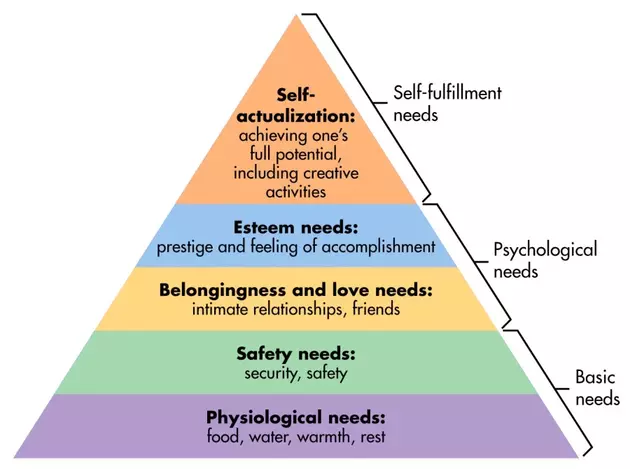Meditation #
What is meditation? #
To try to answer this question, I have studied the contemplative traditions of many of the world’s major religions. For example,
- Christianity ✝️
- Islam ☪️
- Hinduism 🕉️
- Buddhism (Vajrayāna, Mahāyāna, & Zen)
- Daoism (Taoism) ☯️
- Judaism 🕎
I have also studied with a handful of contemporary meditation teachers.1 What I learned is that there is not much consensus about the precise definition of meditation. I prefer to define meditation in IFS terms:
Meditation becomes possible when you are not identified with your parts. Meditation occurs when some proportion of your being is free to radiate Self energy.2
In some traditions, there is a notion of enlightenment or liberation that demarcates some stage of personal transformation. However, we should not be satisfied with personal transformation of any degree; The appropriate benchmark for attainment is global, societal transformation. Everybody should have the opportunity to climb Maslow’s pyramid.

Meditation Techniques #
Meditation is more like a dance than a desk lamp 🪔. There are moves to learn. The techniques that I describe in sub-sections assume that you are already proficient in meditation. Without a basic competence in effortless meditation, you may not obtain any benefit from these techniques. Moreover, these techniques may not work when under the influence of psychedelics.
On breathing #
Use an inspiratory muscle training device to improve your breathing mechanics.
The only meditation technique that I am familiar with is here.
On mantras, prayers, poetry, music #
In a solo context, there is potential for spiritual bypass. A mantra recited vigorously can pave over and hide unaddressed parts with unaddressed issues that would otherwise be in dialog filling your head with thoughts. Suppression is not a good long-term strategy.
In a group context, prayers and music can help synchronize individuals and invite communitas.3
Timing #
The best time to practice meditation is 4:30 to 9:00 (am and pm) in your local time zone.
Sample Schedule #
| When | Activity | Duration |
|---|---|---|
| morning | drink green tea 🍵 | - |
| withdrawal of the senses | 10 min | |
| sahasrara | 5-10 min | |
| lunch | eat calmly and undistracted4 | - |
| before dinner | foot soak & withdrawal of the senses | 15 min |
| sahasrara | 10 min | |
| after dinner | kanna extract | - |
| before sleep | ice on the liver | 15 min |
Take cayenne pepper 🌶️ capsules 💊 with meals.
- Use 300-600mg per day. Capsaicin acts as a relaxing analgesic for TRPV1 in the colin.5
- Serotonin is one of the main neurotransmitters involved in both meditation and psychedelics.6 Serotonin receptors are widely expressed within the gastrointestinal tract.7 (This is suggestive of some kind of causal relationships.)
- You might take cayenne with morning tea.8
- Avoid cayenne pepper on an empty stomach 🧨🔥.
This is just a sample schedule. Customize as per your preference.
Don’t forget fun #
- Kūmāré 2011
- JP Sears offers lots of parodies like Ultra Spiritual Life
- Mob Psycho 100
- Cult of the Lamb
References #
-
Among others, I was a student of Rama a.k.a. Frederick Lenz for a few years. For a retrospective, check out the associated Smoke Screen Podcast. ↩︎
-
IFS is the grand unified theory of religion. ☀️🌜⭐ I admit my claim is a bit bombastic, but check out:
- Carse, J. P. (2009). The Religious Case Against Belief. Penguin Publishing Group.
- Luhrmann, T. M., & Weisman, K. (2022). Porosity Is the Heart of Religion. Current Directions in Psychological Science, 31(3), 247-253.
- Schwartz, R. C., & Falconer, R. (2017). Many minds, one self: Evidence for a radical shift in paradigm. Oak Park: Trailheads.
-
Turner, E. (2012). Communitas: The anthropology of collective joy. Springer. ↩︎
-
Calm and undistracted meals are generally a good idea, but particularly important for lunch. ↩︎
-
Bortolotti, M., & Porta, S. (2011). Effect of red pepper on symptoms of irritable bowel syndrome: Preliminary study. Digestive Diseases and Sciences, 56(11), 3288–3295. https://doi.org/10.1007/s10620-011-1740-9 ↩︎
-
Carhart-Harris, R. L., & Nutt, D. J. (2017). Serotonin and brain function: a tale of two receptors. Journal of Psychopharmacology (Oxford, England), 31(9), 1091-1120. ↩︎
-
Mawe, G. M., & Hoffman, J. M. (2013). Serotonin signalling in the gut–functions, dysfunctions and therapeutic targets. Nature Reviews Gastroenterology & Hepatology, 10(8), 473–486. ↩︎
-
Morré, D. J., & Morré, D. M. (2003). Synergistic Capsicum-tea mixtures with anticancer activity. The Journal of Pharmacy and Pharmacology, 55(7), 987–994. https://doi.org/10.1211/0022357021521 ↩︎
